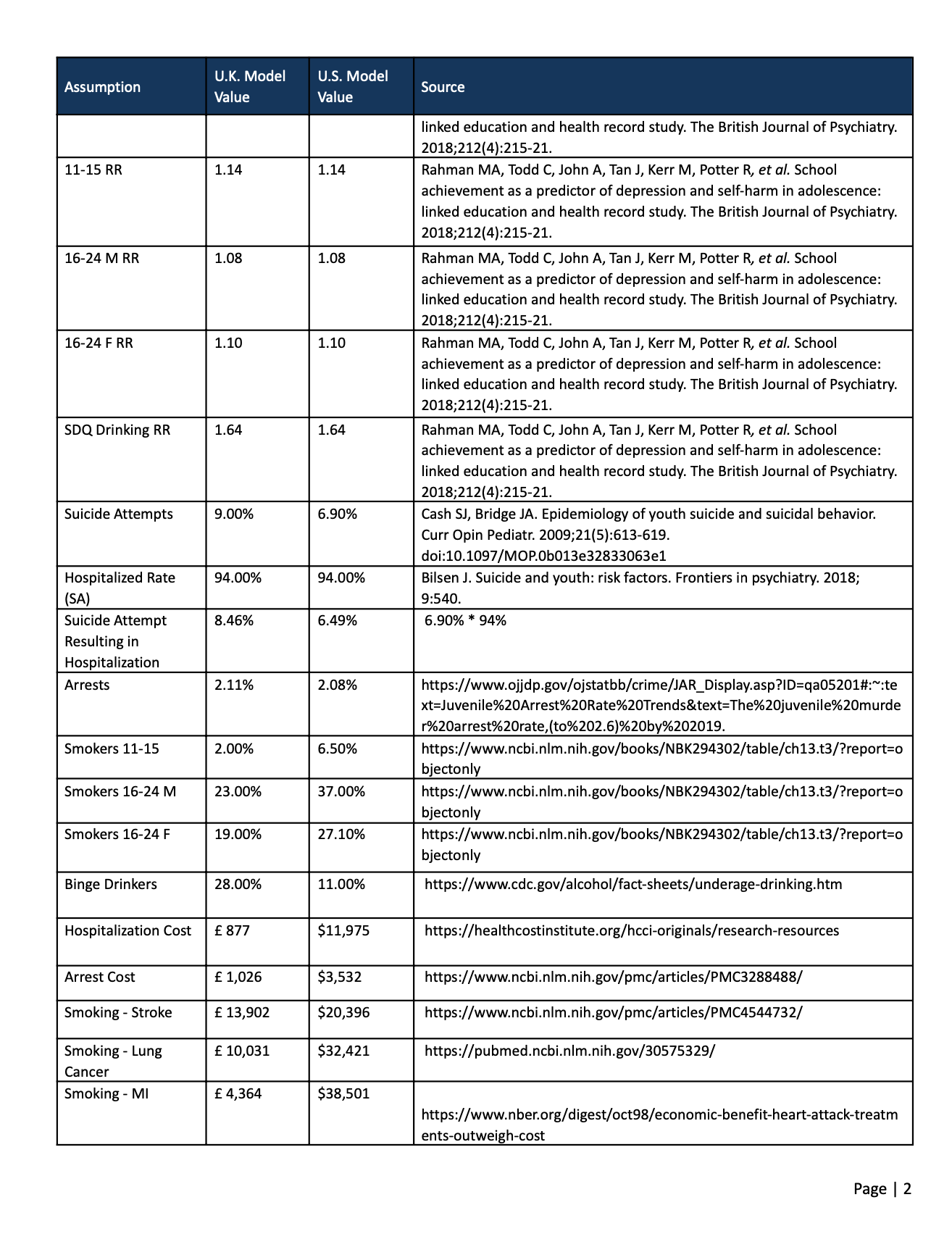
Kooth Economic Value Model Summary Report

Immediate Outcomes
The Kooth program can help to reduce the number of children and young people (CYP) with suicidal ideation, self-harm and perceived impact of difficulties

Impacts
Direct mental health outcomes are linked to reduced healthcare usage, reduced instances destructive behavior and added educational attainment

Economic Impacts
Users of the Kooth program can reduce medical costs by an estimated $790.72 per year with another $18.49 per year in societal benefit
Overview
Mental health among American youth has reached a crisis. With limited existing resources, many children and young people lack the ability to seek appropriate treatment. A scalable and easily accessible service could provide a solution to this public health emergency. The Kooth platform is a mental health web-based platform that is proven to successfully manage the mental health needs of children and young people (CYP) at scale. This work aims to convert a United Kingdom (U.K.)-based evaluation and estimate the potential benefits of the Kooth program in the United States (U.S.) marketplace, including medical cost savings and reduction in negative mental health outcomes.
Summary
The Kooth program has demonstrated success with children and young people and can project significant cost savings, both in terms of medical cost and societal impact. This model estimates fewer young people with suicidal ideation, behaviors of self-harm and perceived impacts of difficulties. By reducing these behaviors, medical costs can be avoided with fewer hospitalizations, physician visits, anti-depressant usage, smoking, crime and drinking while increasing educational attainment.
Medical costs could be reduced by an estimated $790.72 per user while society could see an added $18.49 per user in benefits. For a population of 1,000 children and young people, 92% are expected to have an emerging mental health need (EMHN) and Kooth expects a 76.5% retention rate. Ultimately 704 are expected to engage with Kooth. The total population projected savings related to medical costs is $556,664 with a potential societal impact of $13,019.
The U.K. Model
Kooth commissioned the York Health Economics Consortium (YHEC) to provide an analysis of its web-based mental health platform for CYP in the U.K. YHEC developed an early economic model which can be Americanized to quantify the potential benefits of the platform in the United States and direct future evidence collection.

As part of the analysis, YHEC built a cost calculator to estimate the cost differences to the U.K. government when Kooth is available as an open-source mental health platform. A decision tree structure was used to track the progress of CYP with an EMHN, comparing mental health outcomes between those with and without access to the Kooth platform.
1 Kooth YHEC Model

The immediate mental health outcomes analyzed were (1) Suicidal ideation, (2) Self-harm and (3) Perceived impact of difficulties. These direct mental health outcomes were then linked to a set of economic outcomes and their associated one-year cost to U.K. government services. These were: Hospitalizations due to self-harm, crime, smoking, binge drinking, increases in key stage 3 and 4 (KS3, KS4) educational attainment, reduction in General Practitioner appointments and reduction in the use of anti-depressants.
The U.K. model followed a cohort of 2,160 children and young people with mental health needs. Based on that population and the model’s assumptions, there was an estimated total cost savings of £443,234 less the cost of the Kooth program. The impacts were driven by avoidance of:
- 19 individuals avoided hospitalization due to suicidal ideation or self-harm
- 3 individuals avoided being arrested for committing a crime
- 40 individuals not practicing smoking
- 28 individuals not practicing in binge drinking.
- 35 additional individuals were estimated to attain at KS3 level (12-14 years old)
- 60 additional individuals were estimated to attain at KS4 level (14-16 years old)

Model Development & Structure
The U.S. model is based on the prior work done in the U.K. by Kooth and YHEC. The model follows the previous decision tree format to determine how many individuals within a population will register and engage with Kooth. Subsequent to that, the decision tree utilizes the same published outcomes from the London School of Economics (LSE) utilized by the U.K. model to determine a distribution of immediate medical outcomes. The resulting outcomes determine the population distribution of those with and without Kooth interventions who would experience (1) Suicidal ideation, (2) Self-harm and (3) Perceived impact of difficulties.
Next a link is created between immediate mental health outcomes and a set of intermediate outcomes. These are medical cost and societal events associated with CYP mental health needs where a cost per event is calculated. By utilizing assumed prevalence of intermediate outcomes, risk ratios and linking various outcomes, the estimated number of individuals who then present with such an outcome can be calculated.
For example, with 704 retained users and a prevalence of self-harm of 26.2%, it can be projected that 184 users will have events of self-harm. With an assumption that those who self-harm are 3.32 times more likely to commit a crime and the baseline expected crime rate is 2.1%, it can be estimated that 31.1 individuals in the population are likely to commit a crime without the Kooth program.
The difference in the number of individuals, and cost of intermediate outcome events, with and without the availability of Kooth to CYP, is calculated as a model result. This model result is the economic impact of the Kooth program
Continuing the example, looking at the 184 users who self-harm, Kooth would improve the self-harm scores by 19.1% reducing that group by 36. This results in a cost saving to society relating to the crime those individuals would commit, by reducing the estimated number of individuals who are likely to commit a crime by 1.7 to 29.3 individuals. With an expected cost to society of a crime/arrest of $3,532 the improvement of those individuals is worth an estimated $6,004.
The main difference between the U.S. model and the earlier U.K. model is in the sources of many assumptions. A review was undertaken to identify US-localized inputs for many of the key model components.
2 Kooth YHEC Model
3 Stevens M, D’Amico F, Cartagena-Farias J, Mindel C, Sefi A, Evans-Lacko S. Findings from the Kooth evaluation. Science LSoEaP; 2021. 4 A full list of sources for the US model as well as the comparative UK values will be listed in Appendix A.
U.S Model Inputs
Population
The U.S. Model assumes a starting population of 1,000 individuals of which 100% will register with Kooth. Of that population, 92% are assumed to have an emerging mental health need. This value matches the Kooth U.K. estimate. Based on Kooth experiences a retention rate of 76.5% is expected. 704 users are ultimately expected to be retained.
.png)
Immediate Mental Health Outcomes
A series of changes to baseline and follow up scores for Suicidal Ideation, Self-harm and Perceived impact of difficulties was identified in the LSE report. Kooth experts also conducted a workshop to determine a baseline prevalence of the various immediate outcomes.
These expected baseline prevalence for each immediate outcome are as follows:
-
Suicidal Ideation: 25.3% baseline rate
-
Self-harm: 26.2% baseline rate
-
Perceived impact of difficulties: 71.2% baseline rate
These changes are used to determine the number of individuals estimated to see an improvement in a given outcome.
-
Suicidal Ideation: 8.8% reduction
-
Self-harm: 19.2% reduction
-
Perceived impact of difficulties: 2.2% reduction
Using the baseline prevalence rates and the expected reductions, we estimate that:
-
16 fewer individuals will have suicidal ideation
-
36 fewer individuals will experience self-harm
-
12 fewer individuals will have a perceived impact of difficulties

Economic Impacts from Intermediate Mental Health Outcomes
The immediate mental health outcomes were subsequently linked to a series of secondary outcomes with economic costs. The series of odds and risk ratios between the behaviors and the immediate mental health outcomes are listed in Appendix A. The analyzed intermediate mental health outcomes are: Hospitalizations due to self-harm, crime, smoking, binge drinking, reduction in dropout rates, reduction in General Practitioner appointments and reduction in the use of anti-depressants.
Utilizing the calculations from the intermediate mental health outcomes the following economic impacts were identified:
-
8.6 hospitalizations averted due to Suicidal Ideation and Self-harm for an estimated cost savings of $102,981
-
30.7 smokers averted for an estimated cost savings of $40,107
-
4.5 binge drinkers avoided for an estimated cost savings of $4,691
-
1.8 crimes/arrests averted for an estimated societal savings of $6,358
-
2.4 additional children enrolled in school at age 12-14 for added Federal Funding of $2,422
-
4.2 additional children enrolled in school at age 14-16 for added Federal Funding of $4,239
-
2,346 physician appointments avoided with an estimated cost savings of $276,405
-
138 fewer patients using Anti-Depressants with an estimated cost savings of $132,480
5 Twigg E, Barkham M, Bewick BM, Mulhern B, Connell J, Cooper M. The Young Person's CORE: Development of a brief outcome measure for young people. Counselling and Psychotherapy Research. 2009;9(3):160-68.
6 Child Outcomes Research Consortium. CORE Measurement Tools (CORE-10). 2021. [cited 17.11.2021 Available from: https://www.corc.uk.net/outcome-experience-measures/core-measurement-tools-core-10/.
7 Stevens M, D’Amico F, Cartagena-Farias J, Mindel C, Sefi A, Evans-Lacko S. Findings from the Kooth evaluation. Science LSoEaP; 2021.
The total projected savings related to medical costs is $556,664 or $790.72 for each of the 704 Kooth users while the total projected impact related to societal costs is $13,019 or $18.49 per user. A full list of results is listed in Appendix A.
Scenarios
While the assumptions in this model are slightly conservative, the range of likely actual outcomes may be wide. In addition to the base model, a pair of scenarios were evaluated: one where the improvement in immediate outcomes was slightly worse than the baseline, and another scenario where they performed better than the baseline.
The scenarios assume that:
- The SDQ improvement range is from 1.7% to 3.3% with a 2.2% baseline assumption
- The SIDAS improvement range is from 6.6% to 13.2% with an 8.8% baseline assumption
- The Self-harm improvement range is from 14.4% to 28.7% with a 19.1% baseline assumption
The scenarios would adjust the cost savings estimates to the following:
- Payor related total savings would range from $519,245 to $629,473 versus a baseline estimate of $556,664
- Societal impact would range from $9,991 to $19,427 versus a baseline estimate of $13,019
Limitations
The original YHEC model lists out a number of assumptions and limitations to their framework. As this model is based on the prior U.K. based work, it will have many of those same limitations. These limitations are, briefly, as follows:
- YP-CORE and EMHN Age Based Projections with differing age ranges being projected to the entire population
- Any untreated individuals would remain at their baseline mental health state and not use other support
- Limitations within the original LSE Report around which outcomes and populations were utilized
- The projection of one-month Kooth impacts over a longer period
- Selection of intermediate and economic impacts and the focus on age related educational impact
- Assumption that all users can avoid subsequent physician visits and anti-depressant use
- Use of international risk ratios where local data did not exist
- Two-way causality in risk ratios and variations between mental health and general population rates
Conclusion
The mental health of America’s youth is a longstanding problem that has become a national emergency. This problem is multi-faceted and requires innovative solutions to manage. The Kooth program has demonstrated success with children and young people and can project out significant cost savings, both in terms of medical cost and societal cost. This model estimates fewer young people with suicidal ideation, behaviors of self-harm and perceived impacts of difficulties. By reducing these behaviors, medical costs can be avoided with fewer hospitalizations, physician visits, anti-depressant usage, smoking, crime and drinking while increasing educational attainment.
Medical costs could be reduced by an estimated $790.72 per user while society could see an added $18.49 per user in benefits.



Kooth Plc London
5 Merchant Square, London. W2 1AY
United Kingdom
Kooth Plc Manchester
The Junction, Citibase, Salford. M50 3SG
United Kingdom
Kooth USA LLC
1828 Walnut St, Kansas City.
MO 64108
United States

